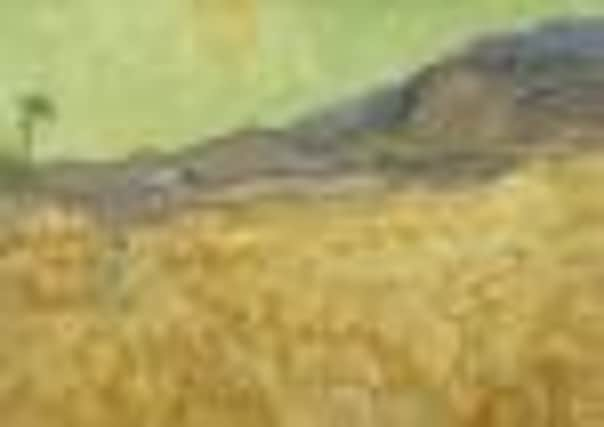Art review: Van Gogh To Kandinsky, Symbolist Landscape In Europe 1880-1910


THE designers have gone to town at the Scottish National Gallery’s big summer exhibition, Van Gogh To Kandinsky. The graphics of bare birch trees in ghostly silhouette that pepper the entrances to the show and shop are reminiscent of the gorgeous Cole and Son woodland wallcovering, which recently gave every fashionable interior a silvery Scandinavian melancholy.
We’ve grown used to the iconography: these aren’t just trees, but trees that provoke feelings. These anxious days a touch of Nordic gloom is part of our cultural wallpaper.
Advertisement
Hide AdAdvertisement
Hide AdSubtitled Symbolist Landscape In Europe 1890 To 1910, this exhibition reminds us that the feeling isn’t new. It takes a period we associate with sunny Impressionism and the relentless march of the urban avant-garde and reminds us of its dark and sometimes rustic shadow, a moment in art that was less a movement than a sensibility, when landscape artists of different historical temperaments and interests imbued their work with an indefinable something else: a ripple of emotion, a pungent whiff of subjectivity.
The most famous Symbolist painting is Munch’s The Scream (a print of which you can currently see across at the Dean Gallery), in which the very landscape vibrates. Symbolist landscape itself was a kind of international judder, of introversion and anxiety, at all kinds of end-of-the-century nastiness: urbanisation, technological advances, and the legacy of Darwin. Symbolists thought of themselves as non-conformists, though they often fell back on a kind of conformity in retreat – ideas of folk history, nostalgia for a lost classical age.
This is a show that looks north, to chilly Finnish landscapes like Aksellen Gallen-Kallela’s glassy Lake Keiteli, and Harald Sohlberg’s mysterious mountains and fjords, beautiful and foreboding in the Norwegian night. There are deserted Danish palaces, the art of Russians, Poles and Lithuanians. There is more Munch than Monet, by a ratio of four to one. It’s a show that, quite justifiably, makes you feel that Belgium, for example, might really be at the heart of things.
But it begins in the south with the setting sun at its back, in a room dedicated to the idea of the lost Arcadia, a culture anxious that the classical inheritance might be lost. There are important paintings here, including work by the Frenchman Puvis de Chevannes, a key influence on the era through his schemes for public decorations. But it’s the wild anomalies I like best, such as a monstrous canvas of the classical world under deluge, by the Russian set decorator Leon Bakst.
Artists try to find new Arcadias – Gauguin and Bernard in Brittany and then Martinique and Tahiti. In the city they proceed through mysterious and unpeopled streets. Le Sidaner paints the brooding abandoned quays of Bruges as though they might be spectral forms rather than bricks and mortar. In Copenhagen, the Amalienborg Palace is deserted and grey in Vilhelm Hammershøi’s painting. The statue of Fredrik V looks like a ruin from classical antiquity. Hammershøi’s rural landscapes are similarly odd; in his flat landscape, Tuesday’s Wood, the clouds gather on the surface of the canvas like scum rising to the surface.
One of the most understated and ominous works in the whole show is Léon’s Spilliaert’s drawing of the Royal Galleries at Ostend. In the dark interior of an infinite colonnade, you can’t help but think you might glimpse the horrors that the Belgian King Leopold II was inflicting on his personal fiefdom in the Congo: ten million Africans dead.
There are some problems with the show. The picture on which its argument most depends, Arnold Böcklin’s Island Of The Dead, was only available on the Amsterdam leg of the exhibition’s tour. It is a gaping hole.
Advertisement
Hide AdAdvertisement
Hide AdAnd there are a couple of moments when the natural expediencies of hanging get dangerous. G F Watts’ vast broiling sun – think one part J M W Turner to three parts Danny Boyle’s Sunshine – should never have been allowed to blaze so bright next to Van Gogh’s small and vastly superior Wheatfield With Reaper.
But then there are so many really fantastic paintings here. And there are absolutely delightful passages. In a final room dedicated to the move towards abstraction there is a wonderful assertion that it was not that convulsive road route via Picasso that is usually recounted, but the siren call of river and sea.
One wall charts an unconscious natural drift from a Whistler river nocturne via a pointillist river scene by Charles Angrand and a coastal view by Paul Signac. Opposite, a sequence of beautiful Mondrian Dune paintings owe little to the observed landscape and everything to some mysterious personal rhythm.
It feels like all this water is a current pulling you out to some destination unknown. And you recognise that mysterious tug, even if you can’t quite name it. It’s a vital and often underlooked undertow in European art.
• Van Gogh To Kandinsky, Symbolist Landscape In Europe 1880-1910 is at the Scottish National Gallery, Edinburgh, until 14 October